
On this month's Special Page:
Ted DiLucia captures a special interview with renown artist Stephen Gervais on illustrating Shirley Jackson's
The Haunting of Hill House
IN THE "SPECIAL PAGE" ARCHIVES:
Laurie R. King
Joe Mynhardt
Luca Paris
John Skipp
Tim Waggoner
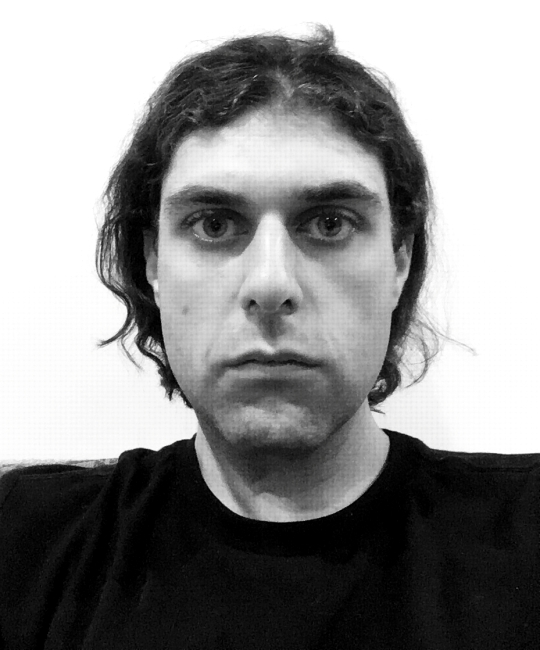
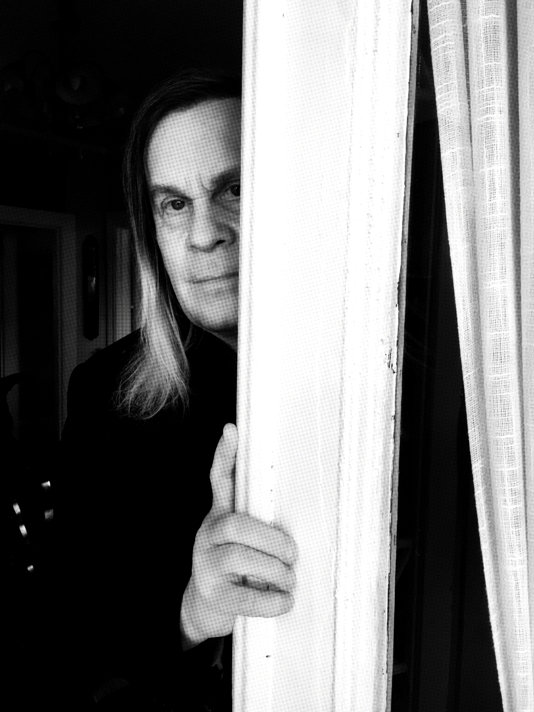
Ted DiLucia (left) and Stephen Gervais (right)
WALKING ALONE
An interview with artist Stephen Gervais
on illustrating Shirley Jackson’s novel
The Haunting of Hill House
by Ted DiLucia
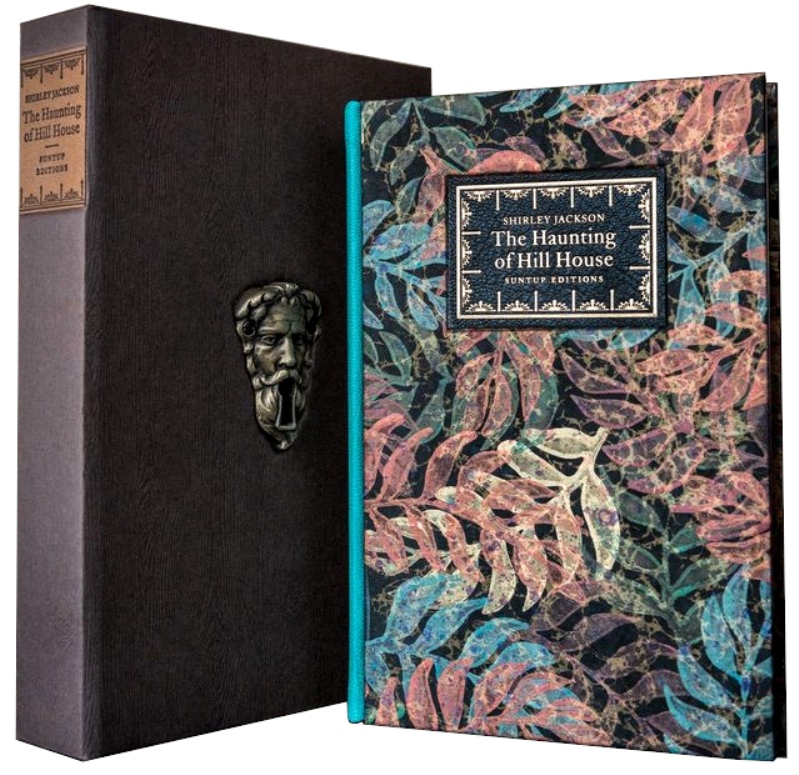
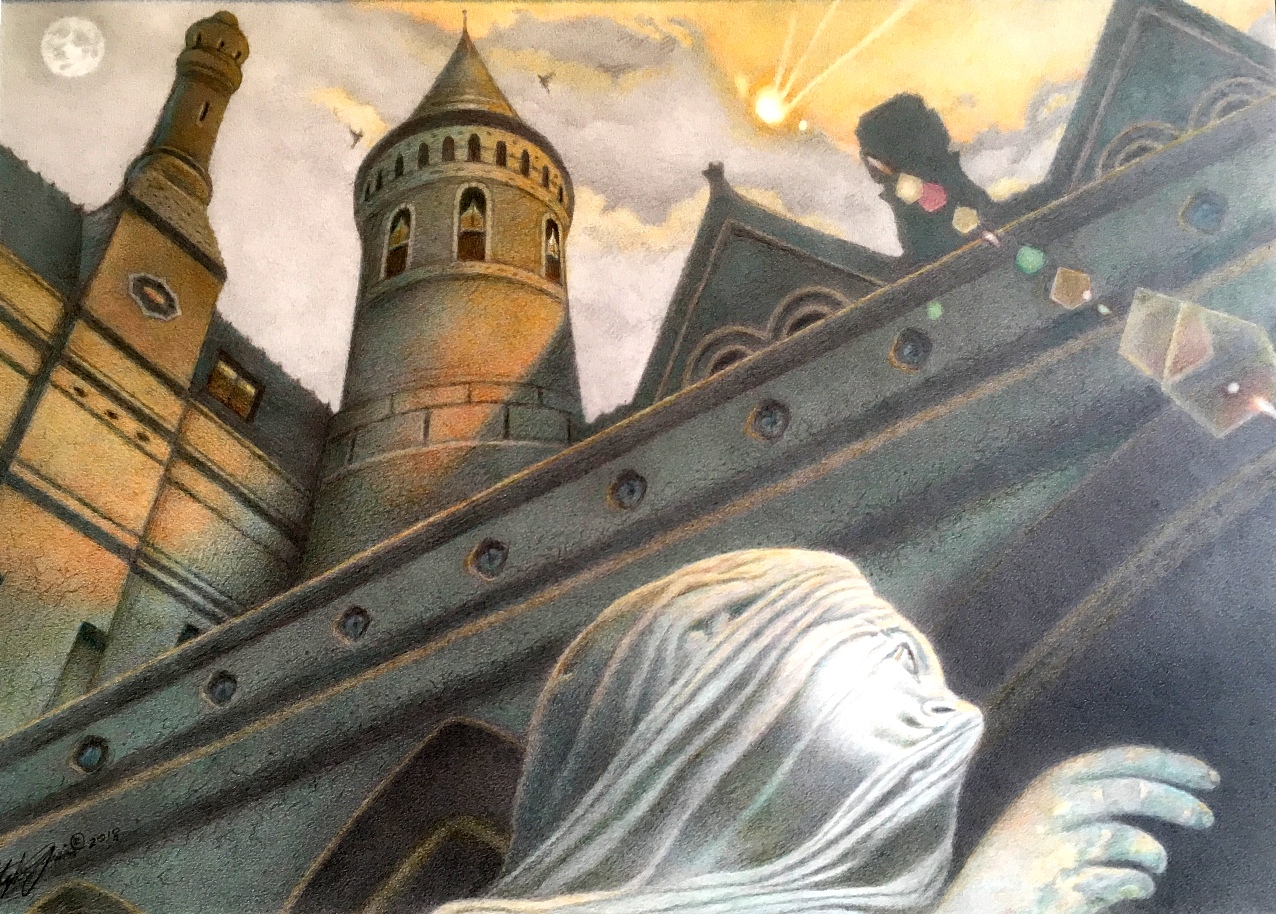
Suntup Edition illustrated by Stephen Gervias
Route 39 to Ashton, turning left onto Route 5 West brought me into Hillsdale, that is where I was going. There, I was to meet the new caretaker of Hill House, who, after the unfortunate events that occurred nearly seventy years ago, was given the keys to watch over the walls that continued to stand upright, see that the floors remained firm, made sure every door is sensibly shut, and by any means disturb the silence that lies steadily against the wood and stone of the place. But the most important thing to do was to care for that which walks alone.
At the corner of the village, more like at the corner edge of nowhere, the taxi driver I rode pulled over into a shanty gas station, met by an old church, to give this clunky checker the old fill-her-up. With the meter running, the cabbie reassured me there would be no charge for the stop, and I, for not being my charming self and wanting make this scruffian a new acquaintance, cut the jib-jab and knew the stop was going to coast me, plus tip.
We drove on toward darker hills. The crooked road, one guarded by two stone lions on either side, was rutted and rocky. Its extremely poor condition, off-set by fully bloomed oleanders, which gave some redeeming grace, but as we continued on six more miles, I could feel the cab’s tires give when they ran out of pavement. Finally, rounding a small curve, the driver slowed the cab to a near crawl as we approached the gates of Hill House.
I left the driver, or rather I should say he left me in a big hurry, and my wallet a bit lighter. On foot up the winding drive, there was Hill House, as it had always been, there, waiting quietly for me. Knocking twice on the heavy iron cherubic knocker, there was no answer. Inside its hall of dark wood and weighty carvings of living things, I listened and waited for my host to appear.
A light from somewhere above turns and there was Stephen Gervais, peering down at me from the wide landing of the heavy staircase. He did not move at first, just stood there, steadfastly pondering in the dim light, and then, in his deep voice said, “Welcome to Hill House, my boy, we have been expecting you…”
Yeah… we.
The two of us chatted over a silver kettle and drank from a set of special China cups, ones with glazed stars gathered at the bottom. First, he told me about the doors—that they had minds of their own and liked to open and close freely without warning, creating drafts which often distract thosewho have come to visit, especially late at night. Stephen recalled that he had come to Hill House to try and capture its essence and mysteries in graphite—that is to say, create a series of pencil drawings, ones that could possibly be used for an upcoming book project. He was then kindly invited to move in while working on his illustrations, and perhaps caretake the sprawling place, at risk of becoming a permanent fixture, much like the chandeliers hung high in the roof beams, or the late blue and rose Victorian wallpaper still decorating the multitude of rooms throughout the dwelling. Around me, stacked on tables were many drawings--quick eye-of-hand sketches of the house, its infamously odd angles, studies revealing its secrets and sorrows, sought to shed an unwavering light onthe things that go bump in the night. And that is why I came to Hill House… to spend a week, perhaps longer, with Stephen Gervais, the man who, for the first time, gave a fresh look to Shirley Jackson’s furiously frightful novel The Haunting of Hill House.
TED DILUCIA: Stephen, thanks so much for the interview--I venture to say that there’s probably no need to book a room in advance, here…(smiles)
STEPHEN GERVAIS: Vacancies are never a problem here Ted—can I call you Ted? People, though, not too many, have roomed here from time to time over the past eighty years, and probably will for the next eighty.
TD: How, um… charming.(sinks into a camelback sofa next).Let me get my pad out here…and pardon the lack of a segway. All right… So, Stephen, when presented with such a task to illustrate such a well-loved, groundbreaking, fiercely guarded novel, what is your first ah-ha, light blub moment… where do you start? What is the initial spark before your pencil hits paper?
SG: (chuckles, pours tea)This spark you speak of, for me, is always I’ve got work! Quickly followed by a second spark, which, in this case was… and it’s the Haunting of Hill House by Shirley Jackson! YIKES!! There’s also a pulse of adrenaline mixed with endorphin, along with a boost to the self esteem and an appreciation of having some good old-fashioned luck! And while there’s still the scent of ozone in the air from all that sparking, the realization occurs that her novel has been fiercely guarded, historically, by the literati and that was a bit sobering, and a bit intimidating. I would rise to the occasion, art wise, and not fuck things up, or produce artwork that was mediocre, or too stylistic. I pictured an angry mob of Jackson fans chasing me down, holding flaming torches, rocks in hand, chanting, not worthy…not worthy!
I found an old paperback edition of Hill House in our library, blew the dust off the top, and reread it with a visual presence of mind, editing out lots of possibilities while reading along. Always a painful process, so I start building alist of scenes I feel are most essential to the novel- the most visually compelling moments.
TD: Routines, rituals, religions… Take me through a day of illustrating in the trenches. You wake up, get out of bed, brush your teeth… then what?
SG: …Drag a comb across my head… What I do is I first go to the kitchen and clean out the cats’ litter box, always fun to do first thing in the morning…then put on coffee, read the Pro-jo… Eventually I get to the studio, and click on CNN or a movie for background. Beyond that, it’s all about sharpening pencils, lining in, then blocking the first pencil work, which always feels like a big thing. I sharpen the Faber Castell, (H-B hardness), or Prisma Color pencil tip with an electric sharpener, very convenient – andI keep my kneaded eraser properly pulled out. Kneaded erasers are so vital to the process. Next, I turn on the combination table lamp, lean forward and start blocking in the drawing, using hot-press, (smooth), 2 ply Bainbridge board. For me, it’s hardly every day of illustrating, more like 4 hours or so, and with breaks!
As for brushing my teeth… toothbrush is near the gargoyle perched over the soap dish in the bathroom, if you’d like to take a look.
TD: After all these years, with the keys to Hill House handed over, finally having the chance to illustrate the book, I’m sure you had scenes from the novel banging on the door of your brain, dying to be translated on paper… How did you choose what scenes to portray? Any regrets?
SG: …Banging on the door of my brain…there’s an image, that explains the migraines…I always try to picture what form the thing pummeling the outside of their door to the hallway might take! What sweet indulgence it would be to pursue an interpretation of that! What would the unseen look like? Curiosity looms large, but Jackson brilliantly chooses not to go there, leaving it heard, but not seen. It’s a pivotal scene, and relies solely on deep, red-noise booms to chill the reader, not visuals. So, sadly, I scratch that one off the list. I’m left with drawing the door bulging inward smoothly, hallucinogenically threatening and obscenely wrong. There are so many moments in the narrative deserving attention, and pursuing the creepiest of those, ones that cause small hairs on the back of the reader’s neck to rise is always gratifying.
Years ago, when I first read the book, it was always fun to imaging what was causing all the tumult out in the hallway: What was it, what might the unseen look like? I mean, part of me wishes that Eleanor had placed an ottoman at the closed door, climbing up and peering out the transom window above the door to catch a delicious glimpse of the unseen entity, another part of me is glad that she left the alleged ottoman alone, best leaving it to the imagination. Such invention would be pure audacity on my part, so… It necessarily remains a mystery, too taboo to illustrate. As with film director, Robert Wise, of the 1963 version of the book The Haunting, I felt the necessity to amplify the threat that was on the other side of the door, who uses a buckling door approach with the sound of splintering wood.
Creating art that challenges and provokes such a visceral response in the reader is sort of controlled power-tripping, which can be very fun. This, combined with some restraint content-wise and using light and shadow also allows the one to fill in some of the blanks more effectively within the illustrated book format.
Now… how’s about another cup of tea? (pours kettle)
TD: Thank you. Illustrating something you have wanted to for so long, were there late nights spent agonizing over getting it right, finding the look, overcoming self-doubt?
SG: Not so much agonizing in the dark, in the night, as it was turning things over and over in my mind, which is just part of the process anyway. I'm a light sleeper, and sometimes I’ll jot down ideas as they occur, then I’ll try to make sense of it all in the morning.
I also use a visualization technique as I lie in the dark, imagining myself walking the halls and rooms of Hill House, as the latter morphs into a memory-palace of sorts where I’m able to walk, making mental notes of visual cues as they loom up from the darkness of the imagination. It does occur to me how lucky I have been, and continue to be, being asked to illustrate mostly genre fiction as it were, and given the chance to reduce life's existential problems down to mostly creative ones.
TD: Were there any earlier attempts, quick sketches of what you envisioned Hill House to be, stashed away before the house finally opened its gates to you?
SG: Years ago, publisher Jerad Walters came to visit from Denver. He and I discussed the possibility of producing a limited edition of The Haunting of Hill House for Centipede Press. He would pursue the legalities of it with the family, as I began to brainstorm and worked up comprehensives for the possible project. Then came news that he had been unsuccessful obtaining permission from the Jackson Estate, so I held onto some of those comps for possible future use, or reference.
Two years later, Paul Suntup of Suntup Press contacted me about selling prints of the cover to Christine, by Stephen King, that I had completed for Donald Grant Publishing back in 1983.
.jpg)
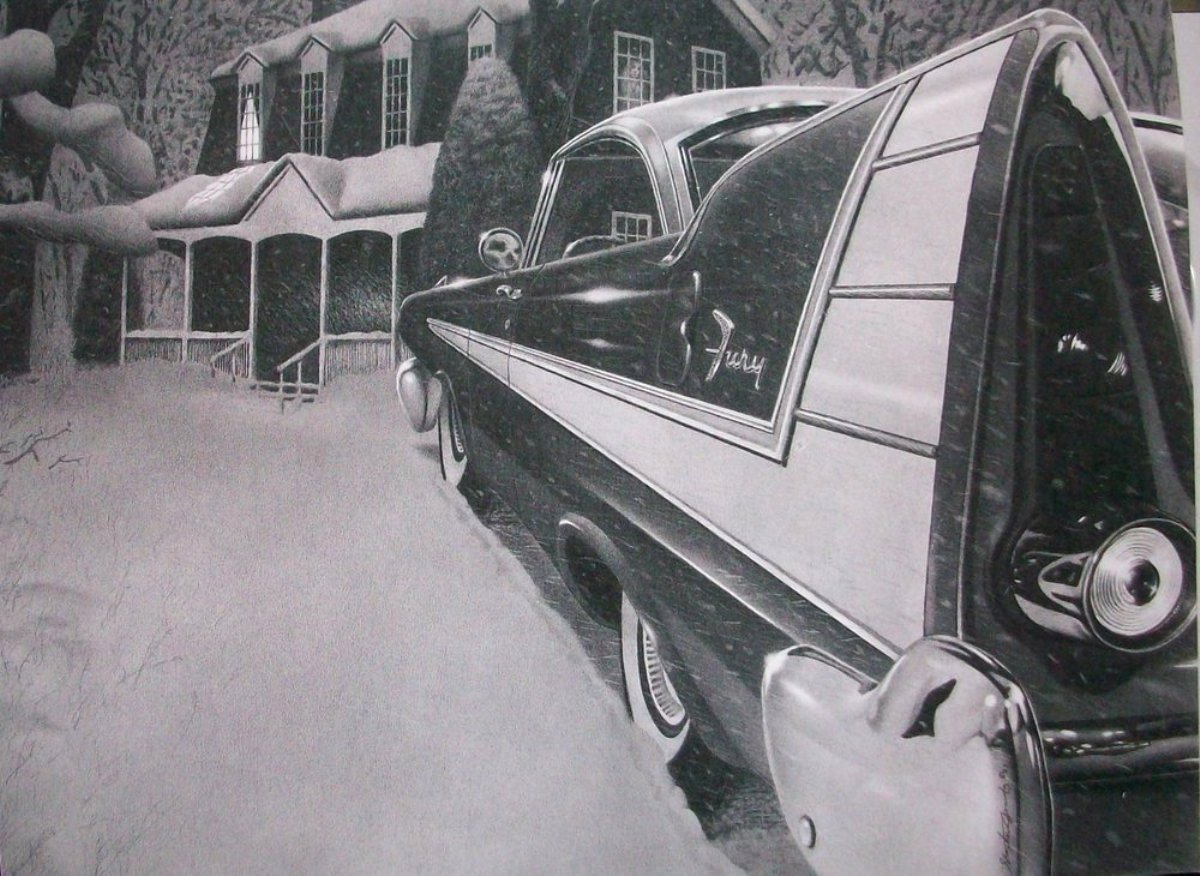
TD: Black and white vs color illustrations?
SG: Again, it’s cost that often figures into whether to go full color or black and white. Usually, the interiors are black and white, and the cover full color, and this combination, I think, often produces a good dynamic. The Suntup publication of The Haunting of Hill House contains a full-color, double-page spread, paginated at its center, which was very cool. The others are all black and white. And by the way, when working on a full color piece, I render the artwork all in black & white first capturing tonal values (believe it or not), and spray that with a layer of workable fixative, and then begin building color values on top of that layer with Prisma colors. The fixative adds a bit of bite to the surface, allowing more ease building up color values. Also, the workable fixative forms a protective layer between the graphite and the waxier color pencil and cuts down on any possible smearing of the two mediums. It’s sort of a mixed medium effort. Then I’ll spray it all with a permanent fixative.
TD: Research. Where did you find your architectural ingredients to build Hill House, and its characters: Eleanor, the main protagonist, Theo, Luke, Dr. Montague, how did you conceptually think of them?
SG: For the interiors and exteriors reference-wise, I was a victim of over-choice, with an abundance of reference material at hand. So I dug into my trusty files, dug into my own stash of photographs, ones that I’d taken down through the years. Reference usual morphs into something quite different from the original image. It’s always an adventure…
One illustration depicts Eleanor Vance standing at the bottom of a stairway, a chandelier hanging overhead, feeling the angst Hill House provides. I chose to just draw Eleanor, she being the all-important pivotal protagonist of the story. I decided that presenting the other members of the group could become distracting from the main narrative. I wanted it to feel as though readers were alone with her as she comes to identify with the house.
I’m often asked to illustrate supernatural horror, so I feel more compelled to use a photorealistic style, one that doesn’t interfere or distract from the narrative. That’s my concern, creating immersive imagery, imagery that does not distract from the narrative, but actually resonates with the narrative.
(soft thumping from somewhere upstairs)
TD: (looks suspiciously around) I hate this question, the ‘what inspires you?’ question, so I’ll ask it this way, what are you thinking of while illustrating?
SG: I’m usually in the moment – dealing with creative problems as they present themselves--how effectively have I lined an image in, how’s the composition. Just dealing with and trying to answer questions as they occur, and how to best finesse things as I go along. News is on in the background and I’m tuning into it or out of it. The world continues to teeter. But it’s the writing, the storytelling itself, along with its place in literary history that inspires me. I feel very lucky that a project like this provides a stage upon which I can share my talent with the built-in reading audience. Plus, it’s always fun to creep people out with the drawings! Hopefully it works to amplify the poignant creepiness of the narrative.
(deep thumping, a distant crash)
Oh, that noise; an old draft that likes to sing its way through the pipes.
TD: Then it comes down to who has more control: the author’s word, or the artist’s image. The words were there prior to any illustration, and have survived pretty well without.
SG: The author has created the story’s universe. Without that, there’s nothing, so it’s probably not a question. The illustrator is just the reporter/messenger. There’s always been a back and forth over whether it’s best not to provide illustrations. Many people believing it’s better to leave things up to the imagination, as an artist’s interpretation can sabotage someone’s own perception, but that’s a whole different conversation. Again, I feel very lucky to be able to share my own vision of the story with others.
TD: There is an immense responsibility that rests upon the shoulders of an illustrator. How do you wrestle with Shirley’s vision and your own? Is there a common ground?
SG: If I got into a wrestling match with Shirley, she’d be able to take me down fast these days what with my long-haul Covid! And I did feel slight (spectral?) pressure on my shoulders from the start. Just by presenting your first question, quote, knowing that I’m illustrating a much-loved novel, etc., framed my own awareness of the situation nicely. The setting she chose for Hill House serendipitously allowed our aesthetic senses to overlap nicely with enough gothic description to satisfy me, and it did help to form the common ground that you speak of. There was no wrestling, but more of slow dance with Shirley.
TD: Deadlines. Do they weaken the work? Do they hinder the full potential of what the illustrator can provide if given more time?
SG: Some deadlines are insultingly short, while other more reasonable ones help an artist rise to the occasion more effectively. Too much lead time can also become a problem. Finessing a piece to death until it turns on the artist and kills them.
TD: How close can we get to a definitive look? Knowing we cannot sit with Shirley and ask her about what she was intending? Whose word is the ‘stamp of approval’ to say this is the definitive look of The Haunting of Hill House, or any book that gets illustrated for that matter?
SG: I think much depends on the working insight of the artist, combined with their stylistic choices. In a practical sense, it’s a small group of people, the author, publisher, editor and artist that give the stamp of approval initially, and ultimately, of course it’s the readership and certainly Jackson fans that do or do not give their collective stamp of approval. I like to think that Ms. Jackson would have appreciated my visual realizations, but alas, we’ll never know. Maybe a séance could be arranged to contact her, get her opinion as such, with the edition in trembling hand.
TD: We’ll leave the answers of yes and no to the living if you don’t mind… we’re doing fine without crystal balls and Ouija boards… just fine. When you conclude the work, are there any regrets? Anything missing? Anything you wished you could go back and fix, illustrate?(darts another worried glance upwards)
SG: Calm yourself Ted... don’t want to dredge out the smelling salts. It’s going to be all right… To answer your question without consulting the spirits, there are always things, hopefully small, that could’ve or should’ve been handled differently, more effectively, here and there. One tries to consider all options such as content, points of view, determination of light sources, etc. So hopefully, all that brainstorming will prove effective enough to please. Also, I should’ve said this earlier, take notes, jot down your thoughts as they occur into a project notebook. This way, nothing’s forgotten. I often jot down thoughts right next to the illustration I’m working on. Otherwise, thoughts will be lost to time.
(closer thumping)
TD: (teacup rattling in hand) What’s next Stephen, where do you walk?
SG: (leans back deeper into the sofa) Well, I’ve always felt comfortable and quite centered here at Hill House, but I am ready to move on to new locations, new projects. This publisher and I have discussed producing a limited edition of The Exorcist by Blatty, speaking of the devil!
With all that said… I set dinner on the dining-room sideboard, six sharp. I take it you can serve yourself properly after your hands have stopped trembling…
…A door slowly swings open by itself… must have blacked out. On waking, everything had turned blue .My bed was blue, the sheets, the walls and ceiling, even the little ottoman placed by the blue door was blue. I have this unsettling feeling I am going to be here for a spell, maybe longer.
Here now, the house stands against its hills. Stephen now embraces the darkness. When everyone is gone, Hill House will still be here, waiting for its next caretaker to mind the walls that continue upright, bricks that meet nicely, floors to remain firm, and that every door is sensibly shut, not to disturb the silence that lies steadily against the wood and stone of this place. Perhaps, just maybe, that person is me, maybe someone else, maybe it will be something that…walks alone.
OTHER ILLUSTRATIONS BY STEPHEN GREVAIS
.jpg)
.jpg)
Stephen Gervais illustration inside NIGHT VISIONS
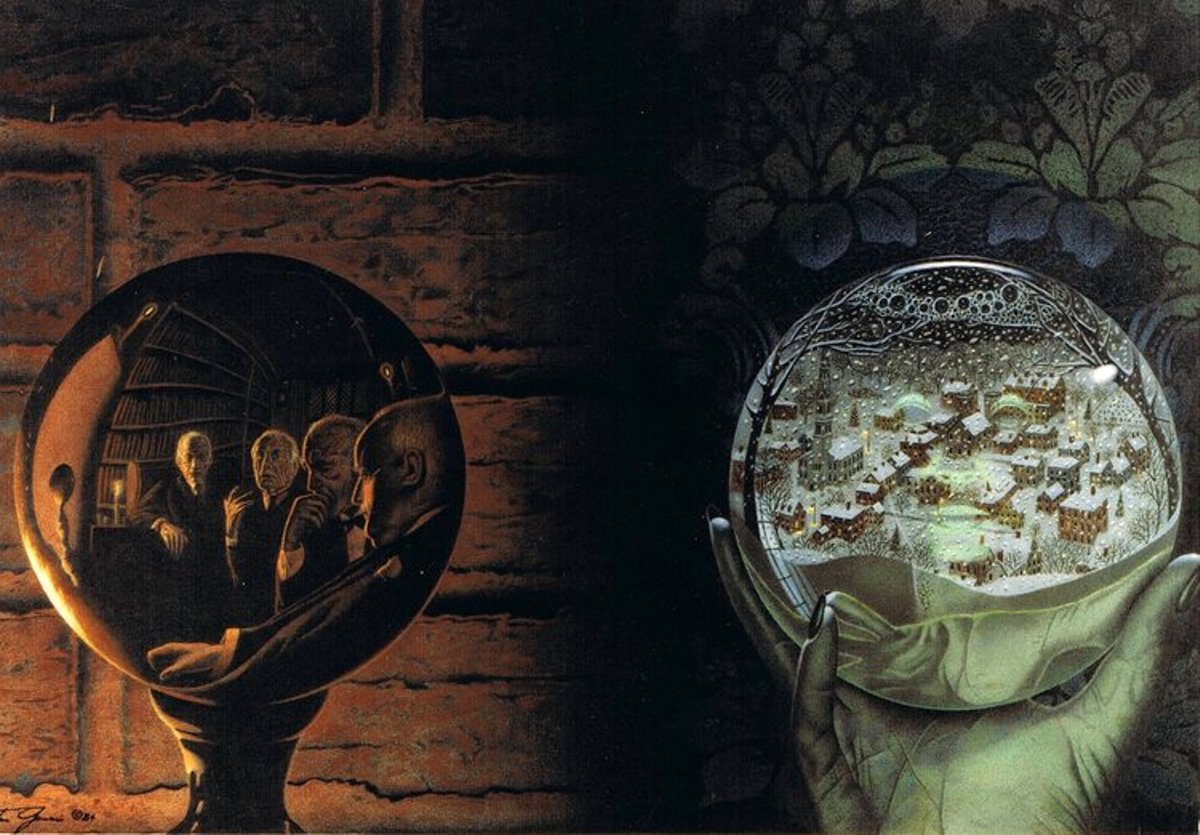
Original image for Peter Straub's GHOST STORY
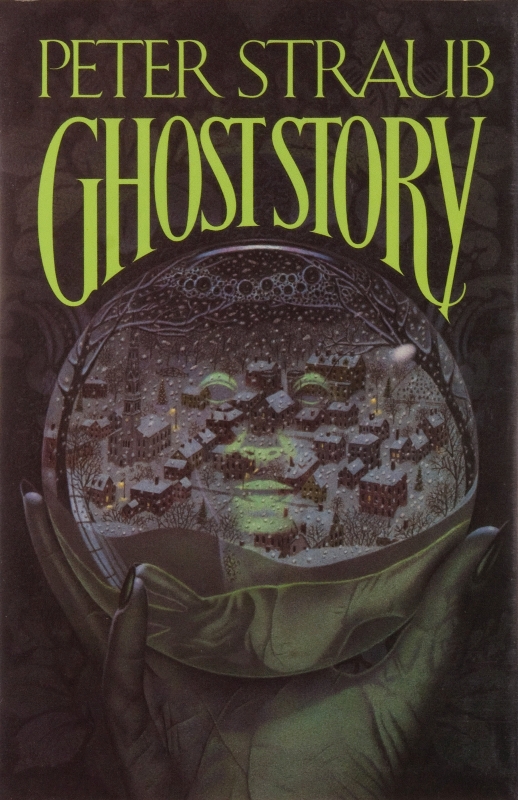
GHOST STORY cover